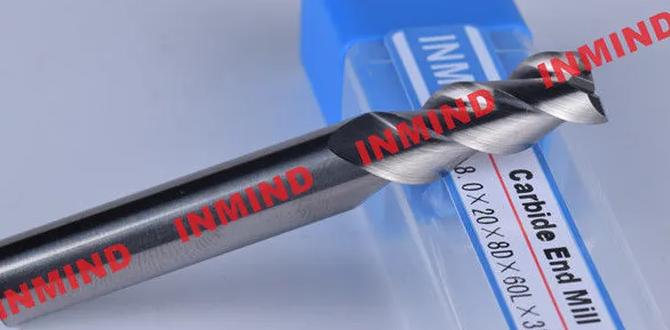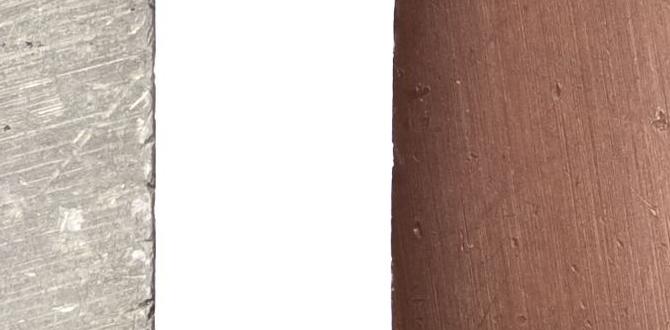Quick Summary
Yes, a 40-degree TiAlN ball nose end mill is often essential for machining cast iron, especially for thin walls. Its coating resists heat and wear, while the ball nose shape is excellent for contouring and preventing undercutting in delicate cast iron parts. It provides a cleaner finish and longer tool life when used correctly.
Hey everyone, Daniel Bates here from Lathe Hub! If you’ve ever tried machining cast iron, you know it can be a bit tricky. It crumbles easily and can wear down your tools faster than you’d like. This is especially true when you’re working with thin walls, where precision and a gentle touch are key. You might be asking yourself, “What’s the best tool for the job?” Well, today we’re diving into a specific hero of the machining world: the 40-degree TiAlN ball nose end mill. It might sound technical, but I promise to break it down so you can understand why this tool is a game-changer for cast iron work. We’ll cover what makes it special, how to use it, and when it’s your best bet for getting that perfect finish without damaging your workpiece. Stick around, and let’s get your cast iron projects running smoothly!
Why Cast Iron is a Machining Challenge
Cast iron, while a fantastic material for many applications due to its strength, vibration damping, and cost-effectiveness, presents unique challenges for machinists. Unlike softer metals, cast iron is brittle. This means it tends to fracture rather than deform under stress, which can lead to chipping and breakage if not handled with the right tools and techniques. Think of it like trying to carve a delicate dessert – too much force, and it crumbles.
The abrasive nature of cast iron, due to the graphite particles within its structure, also means it can significantly increase tool wear. Traditional high-speed steel (HSS) tools might struggle with the heat and abrasion, leading to frequent tool changes and a less-than-ideal surface finish. This is where specialized tooling, like our TiAlN coated ball nose end mill, comes into play. By understanding the material’s properties, we can select tools that work with cast iron, not against it.
Introducing the TiAlN Ball Nose End Mill: What’s the Big Deal?
Let’s break down what makes a “40-degree TiAlN ball nose end mill” so special, especially for cast iron.
The “Ball Nose” Shape
Imagine the tip of the end mill. Instead of being flat or pointed, it’s perfectly rounded, like the tip of a ball. This “ball nose” shape is incredibly versatile. It allows the tool to:
- Cut smooth, contoured surfaces without sharp corners. This is crucial for creating ergonomic shapes or blending surfaces.
- Perform plunging operations straight down into the material, similar to a drill, but with the lateral cutting ability of an end mill.
- Machine complex 3D shapes and pockets where flat-bottomed tools would leave unwanted straight edges or require multiple passes.
- Avoid undercutting. In areas where a flat end mill would create a sharp internal corner that might weaken a thin wall, a ball nose can smoothly transition, preserving the wall’s integrity. This is a huge advantage when working with thin-walled cast iron.
The “End Mill” Function
An end mill is a type of milling cutter. Unlike a drill bit which is designed primarily for making holes, an end mill can cut sideways (laterally) as well as plunge downwards. This makes it perfect for shaping, slotting, pocketing, and contouring.
The “40 Degree” Angle
This refers to the angle of the cutting flutes relative to the tool’s axis. For ball nose end mills, this angle influences how the tool engages with the material and the type of surface finish it produces. A 40-degree helix angle is often a good compromise, offering decent chip evacuation while maintaining tool rigidity and providing a good surface finish on materials like cast iron. It’s not too steep to cause chatter, nor too shallow to trap chips.
The “TiAlN” Coating
This is a game-changer for machining tough materials like cast iron. TiAlN stands for Titanium Aluminum Nitride. It’s a thin, hard coating applied to the cutting tool. Here’s why it’s so important:
- Heat Resistance: Machining generates friction, which creates heat. TiAlN coatings can withstand very high temperatures (upwards of 800°C / 1470°F), preventing the tool from softening and breaking down under heat. Cast iron machining can be hot work!
- Hardness and Wear Resistance: The coating is incredibly hard, which means it resists abrasion from the cast iron particles. This dramatically extends the tool’s lifespan, allowing you to machine more parts before needing a replacement.
- Reduced Friction: The smooth surface of the coating also helps reduce friction between the tool and the workpiece, leading to cleaner cuts and less material welding onto the tool.
- Performance on Harder Materials: TiAlN coatings are particularly well-suited for machining harder materials, including cast irons, steels, and nickel alloys.
Combining these features – the smooth contouring ability of the ball nose, the versatility of an end mill, a forgiving helix angle, and the superior performance of a TiAlN coating – makes the 40-degree TiAlN ball nose end mill an excellent choice for many cast iron applications, especially when thin walls are involved.
When is a 40-Degree TiAlN Ball Nose End Mill Essential for Cast Iron?
While not every cast iron job requires this specific tool, there are key scenarios where it becomes not just beneficial, but essential:
1. Machining Thin-Walled Cast Iron Components
This is where the “essential” part really shines. Thin walls in cast iron are prone to vibration, chatter, and breakage. Here’s why our tool is perfect:
- Minimizing Stress: The smooth, rolling engagement of the ball nose geometry puts less localized stress on the thin wall compared to a flat end mill that might dig in.
- Preventing Undercutting: When machining pockets or contours in thin sections, a flat end mill can sometimes create sharp internal corners that weaken the wall. A ball nose naturally creates a radius, preserving wall strength and avoiding stress concentration points.
- Reducing Chatter: The 40-degree helix angle and the continuous engagement of the ball nose can help dampen vibrations, leading to a smoother cut and less risk of chipping brittle thin sections.
- Controlling Depth of Cut: For thin walls, you often need very shallow depths of cut. The ball nose shape allows for effective material removal even at these shallow depths while maintaining a good surface finish.
For example, think of intricate manifolds, pump housings with delicate internal passages, or even decorative cast iron elements. These often have thin sections where precision and a gentle approach are paramount. Using a standard flat end mill in these situations could lead to cracked or distorted parts.
2. Creating Complex Contours and Radii
If your cast iron part requires rounded edges, spherical pockets, or smooth transitions between surfaces, a ball nose end mill is the natural choice. The 40-degree angle is suitable for many general contouring tasks, providing a good balance between surface finish and material removal rate.
3. High-Volume Production Runs
When you need to machine many identical cast iron parts, tool life becomes a major factor in cost and efficiency. The TiAlN coating on the end mill significantly extends its usable life. This means:
- Fewer tool changes, saving time and reducing downtime.
- Consistent quality part after part, as the tool maintains its cutting edge longer.
- Lower overall tooling costs per part.
4. Working with Slightly Harder Cast Iron Grades
While most cast irons are relatively easy to machine, some higher-strength grades can be more challenging. The heat resistance and hardness of the TiAlN coating help the tool power through these tougher materials more effectively than uncoated tools.
5. Achieving a Superior Surface Finish
For applications where surface finish is critical (e.g., mating surfaces, areas requiring a good aesthetic, or components undergoing further finishing processes), a sharp, TiAlN-coated ball nose end mill often produces a cleaner, smoother finish than other tool geometries or uncoated tools, especially considering the abrasive nature of cast iron.
In essence, when the integrity of thin walls is paramount, when complex curves are part of the design, or when efficiency and tool longevity are key business drivers, the 40-degree TiAlN ball nose end mill becomes an indispensable tool in your arsenal for cast iron machining.
Understanding Your Cast Iron Material
Before we get too far, it’s vital to know what kind of cast iron you’re working with. The properties can vary significantly, impacting your machining strategy.
Types of Cast Iron
- Gray Cast Iron: The most common type. Characterized by graphite flakes which provide good machinability and damping properties but can lead to a somewhat rough surface finish. It’s brittle.
- Ductile (Nodular) Cast Iron: Graphite is in a spherical (nodular) form. This makes it stronger and more ductile than gray iron, but it can be slightly harder to machine and generate more heat.
- White Cast Iron: Very hard and brittle due to carbon present as iron carbide. Extremely difficult to machine and often requires specialized tooling, grinding, or EDM. (This is usually NOT what you’d use a standard ball nose for).
- Malleable Cast Iron: Produced by heat-treating white cast iron. It has improved ductility over white iron but is still relatively strong.
For most general machining, you’ll encounter Gray or Ductile cast iron. The 40-degree TiAlN ball nose end mill is an excellent fit for both, but your specific speeds and feeds might need adjustment based on hardness and machinability.
Key Parameters for Machining Cast Iron with a Ball Nose End Mill
Getting the most out of your 40-degree TiAlN ball nose end mill with cast iron involves setting the right machining parameters. This is where we start balancing cutting speed, feed rate, and depth of cut to ensure good results without damaging the tool or the workpiece.
Speeds and Feeds: A Starting Point
Finding the perfect speeds and feeds can be an art, but here are some general guidelines for a TiAlN coated ball nose end mill in cast iron. These are starting points; you’ll always fine-tune based on your specific machine, tool holder, and the workpiece’s rigidity.
Surface Speed (Vc): This is the speed at which the cutting edge is moving into the material. For TiAlN coated carbide end mills in cast iron, a good starting range is:
- 120 – 200 meters per minute (m/min), which is roughly 400 – 650 surface feet per minute (SFM)
Feed Per Tooth (fz): This is how much material each cutting edge removes with every rotation.
- For a ball nose end mill, the effective feed per tooth is crucial. A common starting point for a diameter range of 6mm – 12mm (1/4″ – 1/2″) might be: 0.03 – 0.08 mm per tooth (mm/z), or 0.001 – 0.003 inches per tooth (ipt).
- Remember, for a ball nose, the effective chip thickness changes depending on the radial depth of cut.
Spindle Speed (n): This is calculated from your desired surface speed and the tool diameter.
- Formula: n (RPM) = (Vc (m/min) × 1000) / (π × D (mm))
- Example: For an 8mm diameter tool at a Vc of 150 m/min:
- n = (150 × 1000) / (3.14159 × 8) = 150000 / 25.13 = approx. 5970 RPM
Feed Rate (vf): This is the actual speed the tool moves through the material.
- Formula: vf (mm/min) = n (RPM) × fz (mm/z) × Number of teeth
- Example (using the 8mm tool at 5970 RPM, 0.05 mm/z, 2 flutes):
- vf = 5970 × 0.05 × 2 = 597 mm/min (approx. 23.5 inches/min)
Depth of Cut (ap and ae)
This is critical, especially for thin walls.
- Axial Depth of Cut (ap): How deep the tool cuts into the material along its axis (vertically). For finishing, this should be very shallow, perhaps 0.1mm to 0.5mm (0.004″ to 0.020″). For roughing, you might go deeper, but always consider the thin walls.
- Radial Depth of Cut (ae): How wide the tool cuts across its diameter. For roughing operations, you might use 50-70% of the tool diameter. For finishing, especially in thin wall applications, you’ll often use a much smaller value, sometimes referred to as “stepover,” which can be as low as 10-20% of the tool diameter to ensure a smooth surface finish and prevent overload.
Table: Recommended Machining Parameters for 8mm Ball Nose End Mill in Cast Iron (TiAlN Coated)
| Parameter | Roughing (General) | Finishing (Thin Wall/Surface Finish) | Units |
|---|---|---|---|
| Surface Speed (Vc) | 150 | 150 | m/min (300-500 SFM) |
| Spindle Speed (n) @ 8mm D | 5970 | 5970 | RPM |
| Feed Per Tooth (fz) | 0.05 | 0.03 | mm/z (0.002 ipt) |
| Feed Rate (vf) | 597 | 360 | mm/min (14 ipm) |
| Axial Depth of Cut (ap) | 3-5 | 0.1-0.5 | mm (0.12″-0.20″ / 0.004″-0.020″) |
| Radial Depth of Cut (ae) / Stepover | 50% D (4mm) | 10-20% D (0.8mm – 1.6mm) | mm (0.03″-0.06″ / 0.03″-0.06″) |
Note: Always consult the tool manufacturer’s recommendations for your specific end mill. These are starting points.
Coolant Strategy
Machining cast iron can produce a lot of fine dust. While some machinists prefer dry machining for cast iron to avoid creating a slurry, using a coolant can significantly help with:
- Chip Evacuation: Flushing away chips, especially important in confined areas or thin sections.
- Cooling: Preventing the tool and workpiece from overheating, which extends tool life and prevents thermal expansion issues in thin walls.
- Lubrication: Reducing friction.
For cast iron, a flood coolant with a good quality soluble oil is often recommended. If you’re aiming for a very clean operation or are concerned about slurry, an air blast or mist coolant can be an alternative, though less effective for heavy chip removal. Be mindful of dust control (using a dust collection system is highly recommended for dry machining).
It’s also worth noting that some high-performance applications may utilize specialized ceramic or carbide tools designed for dry machining of cast iron at extremely high speeds. However, for general-purpose machining with HSS or standard carbide tools, coolant is generally advised.
Best Practices for Using Your 40-Degree TiAlN Ball Nose End Mill on Cast Iron
Simply having the right tool isn’t enough; using it correctly is key. Here are some essential practices:
- Rigid Setup:
- Ensure your workpiece is securely fixtured. For thin-walled parts, consider using a fixture that supports the walls from the outside or a vacuum chuck if applicable.
- Use a rigid tool holder. A good quality collet chuck or shrink fit holder is preferable to a







